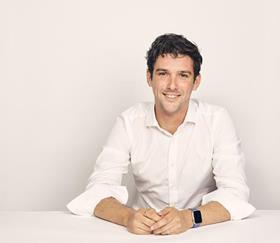Construction is facing a difficult year, with covid-19 restrictions crippling site productivity. Yet at a webinar discussion hosted by ║┌Č┤╔ńŪ°, technology experts shared an optimistic view of how the sectorŌĆÖs responsive adaptations could drive longŌĆæterm improvement.
Looking at ║┌Č┤╔ńŪ°ŌĆÖs headlines over recent weeks, you could be forgiven for feeling gloomy about the future of the construction industry. Social distancing rules have wreaked havoc on sites across the country and seem likely to stay in some form until a vaccine for covid-19 is found.
Stark figures from the Office for National Statistics for 4-17 May revealed that more than one-third of firms in the construction sector saw their turnover down by at least half compared with before the pandemic, while the Construction Products Association has estimated that sector output will drop by 25% this year.
In early June, two of the UKŌĆÖs largest brickmakers announced plans to lay off a combined 600 staff, while housebuilder Taylor Wimpey reported its sales were down by 40% in the first five months of 2020, compared with the same period a year earlier. And just this week Travis Perkins has announced the loss of 2,500 jobs while Multiplex is consulting with staff, 20% of whom are thought to be at risk.
The furlough scheme may have staved off the worst for now, but in an industry famously dependent on cash flow, alarm bells will be ringing for many.
However, the gloom was not shared by a panel of industry experts who spoke at a recent webinar chaired by ║┌Č┤╔ńŪ°ŌĆÖs editor, Chlo├½ McCulloch. Hosted in association with law firm Fenwick Elliott, the four tech specialists invited to discuss how the industry can use technology to plot a route out of the covid-19 quagmire were decidedly optimistic.
>>
On the panel were Andrew Gamblen, digital manager at Willmott Dixon, Stacy Sinclair, head of technology and innovation at Fenwick Elliott, Sam Stacey, challenge director for transforming construction at government agency UK Research and Innovation, and Neil Thompson, digital construction director for the UK and Europe at consultant Atkins.
Each panellist delivered a short presentation about how the industry can adapt to social distancing rules. Where new procedures have been applied, the adjustment has in most cases been rapid. All the experts agreed that the success of many firms in keeping their operations going in the changed circumstances proves the sectorŌĆÖs ability to adapt. Far from crushing the industry, the lockdown has shown what it is capable of when pushed.
The problems
ConstructionŌĆÖs age-old problems are well known, but the difficulties brought about by social distancing rules are entirely new. ŌĆ£We really are feeling our way forwards,ŌĆØ said Gamblen. ŌĆ£We are in an unprecedented time of adversity, and we are learning a lot very, very quickly.ŌĆØ
An immediate challenges facing firms is how to get productivity on sites back up to somewhere approaching sustainable levels. In many cases, the nature of building sites, with groups of workers required to be in close proximity, makes this almost impossible.
Indeed, Gamblen warned that no amount of new technology could enable a site to reach 100% productivity while social distancing rules are in place. He said: ŌĆ£Until that restriction comes off, itŌĆÖs going to be very difficult to get back up to fully 100% because you will need more [workers] on site and itŌĆÖs just not safe to keep that many people that close together.ŌĆØ
We are in an unprecedented time of adversity, and we are learning a lot very, very quickly [ŌĆ”] This period is really starting to showcase things and show better ways of working
Andrew Gamblen, Willmott Dixon
Even the larger lifts at high-rise sites like MultiplexŌĆÖs 22 Bishopsgate, which shut down in March, could carry only about four workers at a time with all occupants standing 2m apart. Maximising output in these circumstances ŌĆō and even when the 2m rule changes to 1m from 4 July ŌĆō requires imagination and the streamlining of every process.
For Thompson, the loss of productivity is driven by behavioural as well as physical factors. He said: ŌĆ£In locking people down and essentially working from home, we have slowed down that ability to share information. We have missed the opportunity for those serendipitous connections with people on building sites and in the office.ŌĆØ
The process of decision-making when working at home, split across myriad interfaces and communication channels and all dependent on an internet connection, has dragged down productivity for offsite staff.
The solutions
For tackling this, said Thompson, ŌĆ£there is no silver bullet. You canŌĆÖt just go and buy one software package.ŌĆØ Instead, to boost the efficiency of remote working, firms ŌĆ£need to start thinking about the user-experience design of making a decision, to reduce the digital touchpointsŌĆØ.
Preventing the spread of the virus on site will require the rapid deployment of contactless technology, according to Stacey. This includes face recognition systems as workers enter and leave sites and the use of digitalised, paperless processing of materials and waste logistics. Echoing Stacey, Gamblen said: ŌĆ£Those that have undertaken this kind of digitisation previously are in a much better position to handle situations like covid.ŌĆØ
>> Sites wonŌĆÖt return to 100% productivity until 2m rule is relaxed, experts warn
>> Government fine-tuning plans to accelerate public sector work awards
Meanwhile, wearable tech installed with bluetooth location tags could keep a check on social distancing on site and alert workers when the 2m rule has been breached. Since the tags would have a record of where the wearer has been, Stacey said that this could also help with contact tracing.
Remote site visits using virtual reality headsets are another workaround. Site inspectors walking around wearing these headsets could soon be a common sight, according to Stacey, who said: ŌĆ£ItŌĆÖs something that has always been desirable for the industry, and I think weŌĆÖll see a massive ramping up of that.ŌĆØ
Sensors embedded within concrete, a technology trialled at London City airport, could also be used to predict strength remotely and ŌĆ£much more accuratelyŌĆØ than existing methods, Stacey said. The tech could be combined with automated construction, a new approach that will be used by Land Securities to build its ┬Ż70m office development in Sumner Street, London, due to start on site this year. It requires 50% fewer workers on site, while reducing capital cost by 10% and materials cost and waste by 30%. UK Research & Innovation hopes the approach ŌĆ£will be adopted much more widely across the industry in due courseŌĆØ, said Stacey.
Without a doubt it is an opportunity to accelerate that culture change in the industry and embed better ways of doing things which will benefit us in the long term
Sam Stacey, UK Research and Innovation
But according to Gamblen, the proper use of tech that is already widespread has helped Willmott DixonŌĆÖs sites get close to pre-lockdown productivity levels. Planning software such as Nureva Span and Dalux has helped offsite staff get back up to speed, while projects that use BIM have taken ŌĆ£much less of a productivity hitŌĆØ than those that do not. Gamblen said: ŌĆ£The understanding of a project by the use of 3D models and the ability to visually communicate the issues in a much clearer fashion than on 2D paper has really helped people come together.ŌĆØ
Echoing Gamblen, Sinclair said the use of existing tech is ŌĆ£really helping with efficiencies and productivitiesŌĆØ for remote working at Fenwick Elliott. She has seen a ŌĆ£huge increaseŌĆØ in the adoption of tools for video conferencing, document sharing and other collaboration platforms in the legal sector, and believes this uptake is ŌĆ£bringing about quite an exciting transformation in the legal industry. A real sea change in the way we are working.ŌĆØ
Innovations adopted by the legal industry include the use of virtual breakout rooms while pursuing dispute resolution procedures online, with parties and their solicitors and advisers all dialling in.
Sinclair has also witnessed the kind of behavioural change of which Thompson spoke. It has been a ŌĆ£transformation of the mindset for people, of the companies, of the cultures and the workflowsŌĆØ, she said. ŌĆ£The legal industry is much more open now to these ways of working. This transformation is really going to open a door for innovation.ŌĆØ
An opportunity
Despite the grim prospect of a global economic slump, a glimmer of hope for the UK economy is that the construction sector may emerge from this crisis more efficient and productive than it has ever been.
ŌĆ£This period is really starting to showcase things and show better ways of working,ŌĆØ said Gamblen, adding that, post-covid, he expects ŌĆ£there will be a huge focus on what actually brings value to the process and removing old and outdated processes that just are not neededŌĆØ.
ItŌĆÖs a challenge that all panellists agree is needed, and for which the industry is now ready. ŌĆ£People say that construction isnŌĆÖt innovative: I disagree. ItŌĆÖs excellent at firefighting ŌĆō itŌĆÖs very good at dealing with an immediate problem,ŌĆØ said Thompson.
ŌĆ£The construction industry often gets a bad rap for not innovating enough, but weŌĆÖre fantastically good at solving problems quickly,ŌĆØ Stacey added.
For Stacey, the time for reform has come: ŌĆ£We have got this horrible crisis at the moment, but without a doubt it is an opportunity to accelerate that culture change in the industry and embed better ways of doing things which will benefit us in the long term.
ŌĆ£I think the net result will be a real step forward for the industry. I see this as giving a real boost to a lot of good things which are happening in the industry and, I hope, building up a sense of momentum around positive changes ŌĆō with significant benefits for all the stakeholders involved in the built environment.ŌĆØ
Digital Innovation: Hear from the experts
The panel members
Chaired by Chlo├½ McCulloch, editor of ║┌Č┤╔ńŪ°, and featuring:

Andrew Gamblen, digital manager at Willmott Dixon

Stacy Sinclair, head of technology and innovation at Fenwick Elliott

Sam Stacey, challenge director ŌĆō transforming construction at UK Research and Innovation

Neil Thompson, digital construction director for the UK and Europe at consultant Atkins




























No comments yet